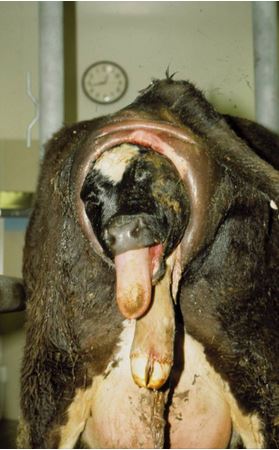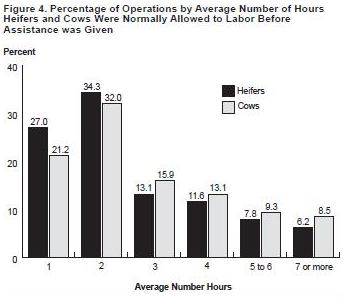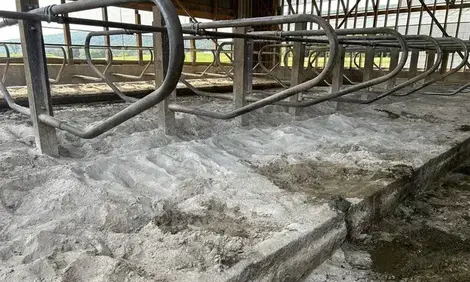



When to Intervene During Calving
When it comes to success at calving, there are some things beyond the farmers control, writes a Kentucky veterinarian.There are "risk factors" that are under the farmers control, but there is little you can do about parity, twins and fetal presentation, writes Dr Michelle Arnold, Extension Veterinarian, University of Kentucky.
Calf Deaths
Perinatal Mortality (PM) generally refers to death of full-term calves shortly before, during, or within 24-48 hours after parturition (calving), writes Dr Arnold. This includes "stillbirth", a term commonly used when calves never take the first breath.
Many genetic and non-genetic factors have been identified but dystocia (a difficult or abnormal calving) is consistently identified as the primary cause of perinatal mortality. In addition, dystocia may contribute to death of a calf up to 4 months of age due to internal injuries sustained at birth, lack of oxygen to the brain during delivery, or failure of passive transfer.
Dystocia rates vary among cattle populations; considerable differences exist among the cattle breeds as well as among individual herds. Maternal, fetal, environmental, and management factors influence PM.
Many of these factors are beyond the control of a producer such as parity (number of calves the cow has already had), presence of twins, and abnormal fetal presentation such as a backwards or breech calf. However, many risk factors can be controlled by the farm manager to decrease the incidence of weak or stillborn calves.
Newborn vitality is essential to the health, survival and welfare of the calf. If the calf is not strong at birth, it may be unable or unwilling to get up and suckle colostrum in a timely manner.
Early colostrum intake is essential for efficient transfer of immunoglobulins, energy, and regulation of body temperature. Not receiving enough colostrum shortly after birth may affect its long term health status (greater risk of disease and death) and lifetime productivity (decreased overall average daily gain).
Calving management, including supervision and intervention, is critical to minimize or prevent calf losses. Perhaps the most critical factor is the timing of intervention during Stage 2 (active labor) of calving.
It has generally been recommended to intervene in the birth process when the feet of the fetus have been visible for two hours ("two feet-two hours rule") but some have challenged this rule because of the uncertainty or confusion of when to start the clock ticking.
The onset of Stage 2 labor has multiple definitions including:
- Appearance of the amniotic sac ("water bag") at the vulva,
- Rupture of the allantoic/amniotic sac (the water bag breaks), or
- Appearance of feet at the vulva. Numerous studies have proven that the total time allowed for Stage 2 should be 2 hours or less provided the fetus is in a normal position.
What Warrants Interference?
A recent (2011) study demonstrated that assisting cows at 80 minutes after the appearance of the water bag clearly decreased the risk of stillbirth. The recommendation to intervene in calf delivery from the specialists at the University of Kentucky is:
- In the case of mature cows, intervene if either the water bag or feet have been evident for 2 hours with little or no progress. Or, if the cow has pushed hard for 30 minutes but the calf has not moved, assistance is needed.
- In the case of heifers, intervene one hour after appearance of the water bag.
- If a cow or heifer has been in Stage 1 (restless, kicking at belly, wringing tail, seeking isolation) for 2-6 hours but does not progress to active straining, intervention is indicated. Cows should progress to Stage 2 more quickly than heifers.
After the cow or heifer is checked vaginally, then a decision for further action such as forced extraction or caesarean section can be made with a reasonable chance of delivering a live calf.
According to the NAHMS 2007-2008 beef study, nearly 50 per cent of operations allowed cows to labor 3 or more hours before assistance was given, and almost 40 per cent of operations allowed heifers to labor an average of 3 or more hours.

Interestingly, the same study reported calves born dead accounted for 44 per cent of all calf death loss during the first 6 months of 2008. An additional 13 per cent died in the first 24 hours after birth. This information highlights how critical the birthing process and early post-partum period is for calf survival.
Frequent monitoring of the calving process is important in order to identify calving problems early. Since the time from appearance/rupture of the sac to appearance of the feet is variable and sometimes may not even occur, it is essential to check cows frequently to identify those experiencing extended or difficult labor. Checking cows every 3 hours is recommended to help early identification of dystocia.
Realistically, checking cows twice daily and three times per day for heifers may be a more workable schedule. One simple way to make this task easier is to feed cows daily at dusk. A study in Iowa found that 85 per cent of the calves were born during daylight hours when cows were fed in the evening rather than morning.
In addition to length of time in labor, the quality of contractions should also be monitored as it may indicate malposition of the fetus, a twin birth, or a metabolic problem. Poor contractions are due to primary or secondary uterine inertia.
Primary causes include conditions such as low blood concentrations of calcium and magnesium, old age, or preterm delivery. Secondary uterine inertia is seen with fatigue of the uterine muscles such as in a prolonged attempt to deliver a malpositioned calf or twins. When a calf is presenting correctly, you should observe two hooves facing down and a nose on top of the legs.
If the nose is not visible (head turned back) or a nose with one or no hooves (leg or legs back), immediate intervention is necessary. If the calf is presenting backwards (two hooves with the pads up), pulling the calf will increase its chances of survival as these calves take a longer time to be delivered naturally. A breech birth (tail first) or uterine torsion is difficult to visually diagnose; if there are no active contractions or no visualization of the feet, she should be checked for a problem.
Many calf losses are attributed to a delay in receiving assistance or the amount of difficulty and time required to remove the calf. Knowing when intervention is required and when to call for professional veterinary assistance can greatly increase the calf's chance of survival.
If you don't know what the problem is call a veterinarian. If you know the problem but you have been unsuccessful correcting it after 30 minutes of trying, call a veterinarian. Losses can be prevented by good supervision and quick intervention when needed.
Signs of reduced vitality in the neonate include peripheral edema (swelling of the head and tongue), scleral hemorrhages (bloodshot eyes), yellow staining of the hair coat, cyanosis of the mucous membranes (blue color to gums), or reduced responsiveness to stimulation. When observed, these are strong indicators that intervention is required. Early intervention is the key; not only does it increase the chance of survival for the calf, but it also greatly increases the pregnancy rate of the cow in the following breeding season.



